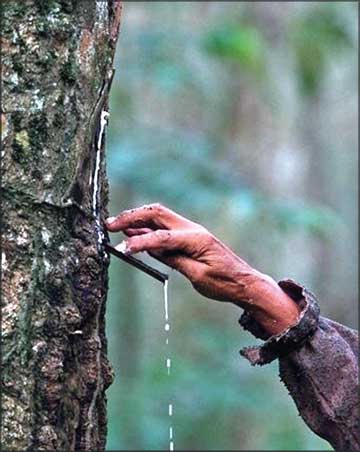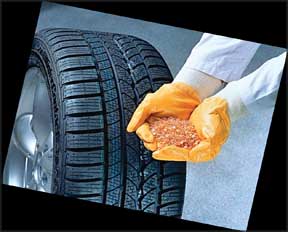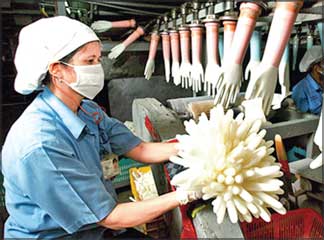‘Rubber industry should develop a vision for 2022’
Dr YOGARATNAM
Despite the impressive progress of Sri Lankan rubber industry, it is
still plagued by a series of vital issues such as: the incapability of
the aged tappers which can affect NR productivity the most, declining
planted area, labour shortage, low land and worker productivity, high
cost of production , inadequate resources, social disparity, poverty in
estates etc.
NR prices
Natural rubber (NR) is perhaps one of the few agro-based industrial
raw materials which gave a decent return to the producers in 2011. NR
price was rising steadily from the beginning of the year and touched US$
6 mark and this upward trend continued until mid-June, 2011. A similar
trend was seen at the Colombo auctions too.

The price came down later owing to the slow growth of the global
economy which impacted the demand for rubber. Declines in rubber price
in the futures market also influenced spot trades. But the market did
not fall flat as demand for rubber did not fall in tandem in view of the
robust growth in vehicle sales and the consequent enhanced demand for
tyres and auto rubber components.
The gravity of the current global economic situation, particularly
the situation in many advanced economies, points to the fact that
putting the economy back to the recovery path may take a much longer
time than what was anticipated a year ago. To be more specific, there is
little possibility for the global economy to return to a recovery path
by first quarter of 2012. Under such an unfavourable global economic
condition, rubber demand is likely to stay sluggish during the first
quarter of 2012.
Vision 2022
Rubber industry should, therefore, develop vision for 2022 to cover
the next 10-year period, for long term sustainability, and set out
revised goals for the industry. This should very broadly include,
enhancing productivity and competitiveness and modernizing both the
coporate and smallholder secters in order to maximise the industry's
contribution to the national economy. In tandem with these rapid
changes, it is vital that the industry re-examines its strategies,
taking into consideration the changing scenario and developments.˙
In this regard, the major strategies should outline the
prioritisation, implementation and the expected outcomes that industry
would undertake in order to ensure the continued viability of a fully
integrated rubber industry through the generation of sustainable income
and returns.
The underlying thrust of the action plans under the strategies should
be to ensure that barriers to the growth of the rubber industry are
removed and the execution of the strategies at the right time to bring
sustainable benefits to the stakeholders.
Value addition
Asia has the largest base in making rubber products. With advent of
the World Trade Organisation and the consequent globalisation of trade,
many multinational companies from Europe and North America started
rubber manufacturing ventures in the cost effective Asian countries,
particularly in China. Most of the natural rubber producing countries
attracted investment of multinationals on account of less labour cost,
availability of technically educated manpower and the major raw
material, ie NR.

This has helped advanced technologies in product manufacture to
percolate into the Asian region and Asia is now better placed to provide
quality rubber products to the world market.˙
In addition to tyres, Asia has supremacy over other continents in
production of industrial, engineering and general rubber goods. Besides
the majors China and Japan, countries like the Republic of Korea,
Taiwan, India, Malaysia, Thailand, Indonesia, Sri Lanka, Philippines,
Israel, Iran, Pakistan, Vietnam and Bangladesh have reasonably good
rubber manufacturing ventures. In the production of dipped goods like
gloves and condoms and medical rubber products, Asia has the virtual
monopoly. That lead is likely to continue unabated at least in the next
decade.
Sri Lanka
Within a relatively short period, the Sri Lankan rubber products
manufacturing industry has successfully evolved from a relatively small
and unknown entity and has become a reputable major world supplier of
quality rubber products.
Sri Lanka has the potential to be one of the world leading rubber
product manufacturing countries due to its production of high quality
raw materials; top quality grade of NR with a very low level of
proteins, high quality production of RSS and relatively low processing
cost. Wide variety of rubber products are currently manufactured by the
rubber manufacturing sector in Sri Lanka.
|

A worker collects rubber-gloves from the production line at
the Top Glove Corp. rubber-glove factory in Klang, Selangor,
Malaysia, on Friday, June 19, 2009. Top Glove Corp., the
worlds largest rubber-glove maker, will announce its fiscal
thirdquarter
earnings on Tuesday, June 23. Photographer Goh Seng
ChongBloomberg News |
Surgical, household, agricultural and examination gloves, balloons,
hallowing masks and rubber toys are among the major products
manufactured by the Latex industries in SL.
Latex industry has expanded significantly over the last decade and
presently it attributes to around 35% of the local consumption of NR.
Some of the leading rubber product manufacturers in the country are ,Ansell
Lanka(Pvt), DSI Group, Loadstar Ltd, Hanwella Rubber Products Ltd, Lalan
Group, Dipped Products Ltd , Trelleborg (Pvt) Ltd, Associated Motorways
Ltd, Richard Peries Grop etc. Loadstar has recently introduced some
innovations in their manufacturing technology by linking nanotechnology.
In terms of export value, the rubber products industry (tyres, tyre
cases,and tubes, plates, sheets and strips, surgical Gloves and other
Gloves, Floor coverings and mats etc.) recorded a high growth of 45%
from Rs 44,163 million in 2009 to Rs 64,033 million in 2010 due to
increased global demand for these products .
Looking at Malaysian?s performance, natural rubber production in 2010
was˙939,241 tonnes compared with˙857,019 tonnes in 2009.˙The domestic
consumption of natural rubber for 2010 was 642,996 tonnes.
The natural rubber consuming industries for 2010 were latex products
(79.3%), tyres (9.8%), general rubber products (7.3%), industrial rubber
products (3.4%) and others (0.2%).˙The rapid growth of the industry has
enabled Malaysia to become the world's largest consumer of natural
rubber latex.
Therefore, continued efforts at value addition should be made in Sri
Lanka, thereby transferring rubber from a ?ommodity?to an ?ndustrial
product. If an earnest effort is attempted in this direction, Sri Lanka
could also, become a leading exporter of NR based products.
Support
The rubber products industry will need to diversify further,
emphasising on high value-added and high technology rubber products,
such as products for engineering, construction and marine applications.
More R&D efforts need to be undertaken in product development and
downstream activities.
New areas for promotion should include the extraction of biochemical
products from latex using biotechnology. These efforts will ensure the
continuous improvement in the products quality to maintain
competitiveness in the export market.
The government should continue to promote the development of Sri
Lanka?s resource-based industries to diversify the country's sources of
growth. In addition to fiscal incentives which are made available for
promoted products and activities, the government should further
fine-tune the incentives to promote specific activities among which is
the rubber products industry. To further encourage investments in
resource-based industries, local companies in the rubber industry that
reinvest to expand their projects should be made eligible for further
Investment Tax concessions.
Therefore, rapid expansion of the rubber products industry can only
be achieved by implementing several factors such as well-planned and
focused industrial growth strategies, unfailing Government commitment,
political and economic stability, stable infrastructure,
forward-thinking Government policies, a large pool of well-trained local
workforce, a pragmatic R & D policy as well as technical and product
testing support.
In line with this aspiration, the industry should continue to
intensify its R&D efforts to give emphasis to the downstream,
value-added sector. Selected areas of R&D in the upstream should
continue to be emphasized in order to maintain the industry?s
competitiveness.
In addition, as one of the world leaders in R&D of NR, the Rubber
Research Board should continue to be a resource centre for the supply of
trained, experienced and highly qualified manpower for the rubber
industry, especially the downstream rubber products sector.˙Research
should also develop low-tech cost effective products for value addition
by Small/ Medium Enterprises themselves.
The RRB should in collaboration with the NIPM continue to conduct
training to fulfill every requirement of the NR industry, including
plantation and industrial courses as well as transfer of technology to
entrepreneurs on the manufacturing of rubber products. In order to
address the issue on tapper shortage, concerted efforts should be made
to train youngsters, whether they are from plantations or in the
villages in the plantation areas, does not matter, and offer an
attractive remuneration package for them to function as tappers.
Smallholder development
The current NR prices of over Rs 400/= per kg has managed to lift a
great majority of smallholders above the poverty line. It has also
managed to bring some of idle rubber areas into production. This price
level has also attracted the estate sector to replant some of their
areas.
Natural rubber should therefore be regarded as a strategic crop. Its
socio-economic importance cannot be denied as it sustains the livelihood
of about 130,000 smallholder families in the Low Country Wet and
Intermediate Zones. The economic well-being of the smallholders is thus
of considerable concern to ensure continuous stability in the rubber
sector in the rural areas.
The current and future prices will be the determinant factors in the
selection of the crop to be planted when the old trees are due for
replanting. Any selection of crop to be planted will take at least 20
years cycle before replanting again.
Due to traditionally depressed and protracted low NR prices in the
1990s and 2000s, few rubber areas were converted to other more lucrative
crops, especially oil palm (with no regrets now).˙Therefore, to
encourage the existing smallholders to remain in rubber as well as to
encourage other smallholders to venture into rubber cultivation, NR
prices must remain remunerative and ensure sustainability of the
industry. Smallholder extent is expected to grow further in Sri Lanka
with rubber being planted outside the traditional areas although the
level of productivity is debatable in such areas.
Productivity
Another area of priority is Productivity. In Sri Lanka, the rubber
small holding sector has been contributing significantly.
Their contribution in 2010 was around 79 % of the national
production. Five years ago, it had been 65 % by the smallholders and 35
% by the RPCs. Despite several constraints, the smallholder sector has
been demonstrating an increasing trend in performance with an increase
of 16 % over their production in the previous year. Sri Lankan
smallholdings productivity is in the region of 1290 kg/ha where as in
Malaysia it is around,1330 to 1440 and in Indonesia it is in the range
of, 1250 to 1500 kg/ha. However, Sri Lanka?s national productivity is in
the region of 1437 kg/ha, which probably is due to higher productivity
in the corporate sector.
Land productivity potential suggests that Sri Lanka has the capacity
to increase her total production by increasing productivity levels in
existing areas by replanting with high yielding clones and following
accepted management practices.
Achieving a productivity of 2000 kg/ha/year and a total production of
about 200 mn kg from a tapped area of about 100, 000 ha by 2020, should
be the industry's goal.
Conclusion
Rubber growers in Sri Lanka are still making huge profits with NR
prices stabilizing around Rs 400/= per kilo and the cost of production
around Rs 250/=.
The tyre Industry, however has been passing through an extremely
difficult phase of continuous and significant increase in the price of
natural rubber and other key raw materials.
Since raw materials account for approximately 70 per cent of industry
turnover, the input cost pressure has resulted in severe erosion of
their net margins. |



